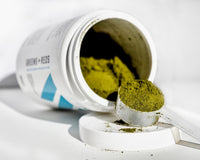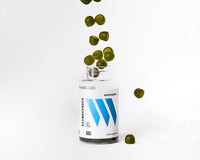Most of us don’t think about how we can improve our joint health, until our joints start acting up, aching, and causing us severe pain that is. Being competitive is a great thing, but it also puts a large amount of physical stress on your joints, especially when training at high-intensities, and working under heavy loads when you’re lifting. Regardless of age, it’s imperative to prophylactically safeguard your joints while training, instead of waiting until you have major joint issues and debilitating pain. Thus, we compiled these 6 simple steps on how to reduce joint pain from exercising.
1. Balance High And Low Impact Training
High-impact training such as sprinting, running, plyometrics, and agility drills can cause severe physical stress to your joints and connective tissues. By balancing high-impact exercises such as box jumps with resistance training and low-impact movements, you will strengthen the muscles that protect your joints, to further stabilize and shield them from injury and increased joint pain. Low-impact resistance training, will help reduce joint pain before it even starts, especially if you're crossfitting.
RELATED ARTICLE HIFT Vs HIIT Training
Knee joints are the worst! A large body of evidence purports, that knee joints have been identified as the highest risk to subsequent injury from high-impact and heavy load bearing exercises [R, R] The meniscus is a C-shaped piece of tough, rubbery cartilage that acts as a shock absorber between your shinbone and thighbone. It can be torn if you suddenly twist your knee while bearing weight on it. Competitive athletes are at more risk, whose sports repetitively stress the structures of the knee, and have higher rates of early onset Osteoarthritis [R]. By incorporating low-impact resistance training to your workout programming, you can help safeguard your joints from increased pain due to physical stress.
2. Supplement With Krill Oil
Krill Oil is edible oil, extracted from small crustaceous found in the deep waters of the Antarctic Ocean. Krill oil contains high amounts of essential omega-3 fatty acids, (EPA) eicosapentaenoic acid and (DHA) docosahexaenoic. which have been proven to help reduce inflammation and aid in the treatment of chronic inflammatory disease of the joints, such as Rheumatoid arthritis (RA) [R]. Clinical trials have also shown that Krill Oil can help in treating patients with mild forms of joint and knee pain [R].
RECOMMENDED PRODUCT Krill Oil + Astaxanthin (60 Servings)
Furthermore, Krill oil naturally contains a potent and powerful antioxidant Astaxanthin. Astaxanthin has been shown to fight free radical damage and oxidative stress and plays a crucial role in reducing inflammation of the cardiovascular and immune system [R]. This can be a beneficial anti-inflammatory element especially if you’re training on a consistent basis.
Research has shown that the anti-inflammatory effects of Astaxanthin can help reduce joint pain and chronic inflammation of the tendons and joints, which can cause detrimental effects to your training and recovery.
In a randomized, double-blind placebo-controlled trial by the Journal of the American College of Nutrition, 90 patients were recruited with rheumatoid and or osteoarthritis to evaluate the effectiveness of krill oil on arthritic symptoms. The results were astounding. After seven days of treatment with a dose of 300mg of administered krill oil, patients reported reduced pain scores by 28.9%, reduced stiffness by 20.3%, and reduced functional impairment by 22.8% [R]. Pretty impressive if you ask me.
RELATED ARTICLE The World’s Most Powerful Antioxidant Astaxanthin
Some of you might already take an Omega-3 supplement like Fish Oil, or Flaxseed Oil. But, research has shown that the therapeutic benefits of Krill Oil are far superior to other Omega-3 supplements due to its high bioavailability or how quickly your body can absorb it. The faster and better the absorption, the more efficient your body can use it. I know what you’re thinking! Why is Krill Oil better than Fish Oil? The Omega-3s found in krill oil are packaged as phospholipids, which are the same structure found in your cellular membranes. The Omega 3’s found in fish oil, however, are bound in triglycerides, which have to undergo additional conditions and processes in order for them to become bioavailable [R]. In fact, Krill oil has been shown to be absorbed 68% better than fish oil [R].
RELATED ARTICLE Krill Oil Vs Fish Oil: Why Krill Oil Is The Best Omega-3 Supplement
3. Drink More Water
Water accounts for 80% of your connective tissue and body’s cartilage. If you don’t drink enough water, then your body will pull excess water from the reserves around your cartilage tissues and surrounding joint areas, causing a mishap on your bendable body parts and potentially causing joint pain.
RELATED ARTICLE 8 Tips To Help Make Drinking Water More Fun
Instead of drinking energy drinks, diet soda, or juice, buy yourself a 21-ounce Hydro Flask and start hydrating yourself on a regular basis throughout the day. This will ensure that you’re getting an adequate amount of water throughout the day, so you can keep your joints healthy and strong. If you have severe joint pain, then adequately hydrating, will definitely help reduce your joint pain.
RELATED ARTICLE Are Energy Drinks Bad For You?
4. Supplement With Collagen
Another amazing supplement to help reduce joint pain is Collagen. Collagen is the latest and greatest thing to hit the health and wellness world due to its extensive list of proposed health benefits.
Collagen is a structural protein, specifically a polypeptide containing a mixture of the amino acids glycine, proline, and lysine. As one of the most abundant proteins in the human body, Collagen consists of nearly one-third or 30% of total human protein. Collagen is engrained within the connective tissue of animals and humans, specifically found in the cartilage, tendons, muscles, and bones (think of Collagen, as the glue that holds everything together) [R].
Your body naturally produces collagen from certain vitamins and minerals from the food you eat. However, Collagen production naturally declines as you age. When the production of Collagen declines, you’re met with wrinkles, sag, and sometimes even cellulite, which is completely natural considering your body is not capable of repairing itself like it did when you were younger. [R].
RELATED ARTICLE The Ultimate Guide To Collagen: What Are The Benefits Of Taking Collagen?
Research has shown that Collagen, specifically hydrolyzed collagen promotes an anabolic or building effect on cartilage tissue. In a prospective, randomized, placebo-controlled, double-blind study conducted at Penn State University 147 collegiate athletes, (72 male, 75 female) were randomly administered 10g of hydrolyzed collagen or a placebo. After 24 weeks, the results showed a significant improvement of joint pain, joint strength and resilience in athletes who were treated with the collagen hydrolysate. [R]. This is particularly important for endurance athletes since joint pain can have a negative impact on athletic performance. If you want to see the results for yourself, you can download the clinical study HERE.
Overall, Collagen Hydrolysate is an amazing supplement that can help you reduce joint pain, rebuild cartilage tissue, and increase joint strength.
RECOMMENDED PRODUCT Collagen Hydrolysate (45 Servings, Unflavored)
5. Work On Mobility
Increasing your body’s range of motion (ROM) can dramatically improve muscular and joint function. When you can smoothen a movement with an increase in ROM, excessive pressure on each muscle surrounding a joint is reduced. When your joints are stiff, they can cause disruption in other areas of the body, creating postural imbalances, and increased joint pain. Static and dynamic stretching can increase joint mobility and improve ROM, which will help improve overall joint function [R].
Including daily or weekly mobility sessions into your routine can reduce tension in your joints, and improve motion through heavy movements.
6. Supplement With Turmeric
Turmeric, is a rhizomatous herbaceous perennial plant (Curcuma longa). Sometimes referred to as Indian Saffron or the golden spice, Turmeric is part of the Ginger family and is a tall plant that grows in Southeast Asia and cultivated in India. The turmeric that you find in supplements is directly derived from the plants roots. Through several studies, Turmeric been proven to provide countless health benefits from improving joint health and mobility, reducing exercise-induced inflammation and muscle soreness, thus enhancing recovery and performance.
RECOMMENDED PRODUCT Turmeric Curcumin (750mg)
In vivo animal studies, have shown that curcuminoids contribute to anti-arthritic effects, helping to reduce joint swelling and inflammation, up to 48% [R ,R]
This can be especiallybeneficial for athletes and active individuals to help reduce exercise-induced inflammation and promote faster recovery. Often times, joints can produce inflammation from stress-related movements and can result in pain and discomfort, and result in further stress-related injury.
While many people opt to treat post-workout inflammation with prescribed, or over-the-counter anti-inflammatory medications such as Ibuprofen, those treatment options can pose serious health risks. Turmeric can provide an all natural, safe, and effective treatment option, free of synthetic chemical constituents, and side effects to help treat joint inflammation and health.
RELATED ARTICLE Should You Take Ibuprofen After Your Workout?
How To Reduce Joint Pain: Takeaway
The best thing for your joints is to be proactive and safeguard yourself before you cause injury. By adding in these six simple steps to your daily regimen, you’ll help reduce your joint pain from exercise and be able to strengthen and improve your joint health to continue living a healthy active lifestyle. Also, check out the 6 best supplements for joint health.
Need help strengthening and reducing your Joint Pain?
Swolverine's Collagen Protein is made with pure hydrolyzed collagen peptides. Unflavored and virtually tasteless, you can add it to your coffee, smoothies, shakes, and even to your baking recipes to get an added boost of protein whenever you may need it. Collagen can help replenish your body with the vital protein you need to build lean muscle mass, strength, and help support healthy joints and glowing skin.
SWOLVERINE is an endurance athlete and active lifestyle brand. Made for the elite athlete, and the strong-willed our products were designed to fuel your athletic performance. We perform when you perform.
We believe that everyone can optimize not only their athletic performance but their human potential. The way we believe we can optimize performance is through transparency, clinically effective doses, and clinically proven ingredients with evidence-based outcomes. We provide the nutrients you need to power your active lifestyle.
References
- Felson DT, Lawrence RC, Dieppe PA, et al. Osteoarthritis: new insights. Part 1: the disease and its risk factors. Ann Intern Med. 2000;133:635–646.
- Gelber AC, Hochberg MC, Mead LA, Wang NY, Wigley FM, Klag MJ. Joint injury in young adults and risk for subsequent knee and hip osteoarthritis. Ann Intern Med. 2000;133:321–328
- Hunter, David J and Felix Eckstein. “Exercise and osteoarthritis” Journal of anatomy vol. 214,2 (2009): 197-207.
- Senftleber, Ninna K et al. “Marine Oil Supplements for Arthritis Pain: A Systematic Review and Meta-Analysis of Randomized Trials” Nutrients vol. 9,1 42. 6 Jan. 2017, doi:10.3390/nu9010042
- Suzuki, Yoshio et al. “Krill Oil Improves Mild Knee Joint Pain: A Randomized Control Trial” PloS one vol. 11,10 e0162769. 4 Oct. 2016, doi:10.1371/journal.pone.0162769
- Da Boit, Mariasole et al. “The Effect of Krill Oil Supplementation on Exercise Performance and Markers of Immune Function” PloS one 10,9 e0139174. 25 Sep. 2015, doi:10.1371/journal.pone.0139174
- Deutsch L. Evaluation of the effect of Neptune Krill Oil on chronic inflammation and arthritic symptoms. J Am Coll Nutr. 2007;26(1):39-48.
- Ulven, Stine M, and Kirsten B Holven. “Comparison of Bioavailability of Krill Oil versus Fish Oil and Health Effect.” Vascular Health and Risk Management11 (2015): 511–524. PMC. Web. 20 Aug. 2017
- Schuchardt, Jan, et al. “Incorporation of EPA and DHA into plasma phospholipids in response to different omega-3 fatty acid formulations - a comparative bioavailability study of fish oil vs. krill oil.” Lipids in Health and Disease, vol. 10, no. 1, 2011, p. 145., doi:10.1186/1476-511x-10-145.
- Clark KL, Sebastianelli W, Flechsenhar KR, et al. 24-Week study on the use of collagen hydrolysate as a dietary supplement in athletes with activity-related joint pain. Curr Med Res Opin. 2008;24(5):1485-96.
- Shoulders, Matthew D., and Ronald T. Raines. “COLLAGEN STRUCTURE AND STABILITY.” Annual review of biochemistry78 (2009): 929–958. PMC. Web. 20 Aug. 2018.
- Varani, James et al. “Decreased Collagen Production in Chronologically Aged Skin : Roles of Age-Dependent Alteration in Fibroblast Function and Defective Mechanical Stimulation.” The American Journal of Pathology6 (2006): 1861–1868. PMC. Web. 20 Aug. 2018.
- Choi, Jung-Hyun et al. “The effects of taping, stretching, and joint exercise on hip joint flexibility and range of motion” Journal of physical therapy science vol. 28,5 (2016): 1665-8.












